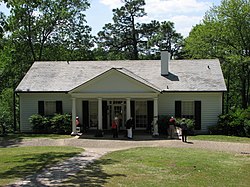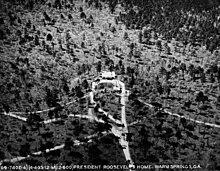
Warm Springs is a city in Meriwether County, Georgia, United States. The population was 465 at the 2020 census.
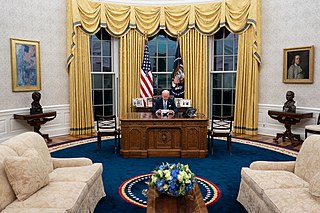
The Oval Office is the formal working space of the president of the United States. Part of the Executive Office of the President of the United States, it is in the West Wing of the White House, in Washington, D.C.

The unfinished portrait of Franklin D. Roosevelt is a watercolor of Franklin Delano Roosevelt, President of the United States, by Elizabeth Shoumatoff. Shoumatoff was commissioned to paint a portrait of Roosevelt and started her work around noon on April 12, 1945. At lunch, Roosevelt complained of a headache and subsequently collapsed. The president, who had suffered a cerebral hemorrhage, died later that day.

F.D. Roosevelt State Park is a 9,049 acres (36.62 km2) Georgia state park located near Pine Mountain and Warm Springs. The park is named for former U.S. President Franklin Delano Roosevelt, who sought a treatment for his paralytic illness in nearby Warm Springs at the Little White House. The park is located along the Pine Mountain Range. The western portion of the park, formerly named Pine Mountain State Park, was named a National Historic Landmark in 1997. F.D. Roosevelt State Park is Georgia's largest state park.

The Franklin D. Roosevelt Presidential Library and Museum is a presidential library in Hyde Park, New York. Located on the grounds of Springwood, the Roosevelt family estate, it holds the records of Franklin Delano Roosevelt, the 32nd president of the United States (1933–1945). The library was built under the President's personal direction in 1939–1940, and dedicated on June 30, 1941. It is the first presidential library in the United States and one of the thirteen presidential libraries under the auspices of the National Archives and Records Administration.
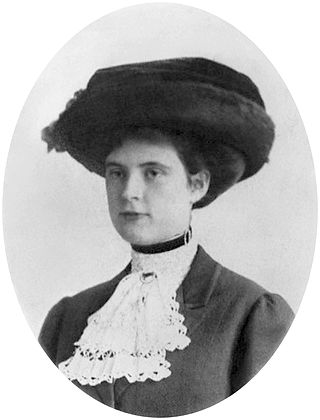
Lucy Mercer Rutherfurd was an American woman who sustained a long affair with US president Franklin D. Roosevelt.

Warm Springs is a 2005 made-for-television biography drama film directed by Joseph Sargent, written by Margaret Nagle, and starring Kenneth Branagh, Cynthia Nixon, Kathy Bates, Tim Blake Nelson, Jane Alexander, and David Paymer. The screenplay concerns U.S. President Franklin D. Roosevelt's 1921 illness, diagnosed at the time as polio, his struggle to overcome paralysis, his discovery of the Warm Springs resort, his work to turn it into a center for the rehabilitation of polio victims, and his resumption of his political career. Roosevelt's emotional growth as he interacts with other disabled people at Warm Springs prepares him for the challenges he will face as president during the Great Depression.

The Home of Franklin D. Roosevelt National Historic Site preserves the Springwood estate in Hyde Park, New York, United States. Springwood was the birthplace, lifelong home, and burial place of the 32nd president of the United States, Franklin D. Roosevelt. Eleanor Roosevelt is buried alongside him. The National Historic Site was established in 1945.
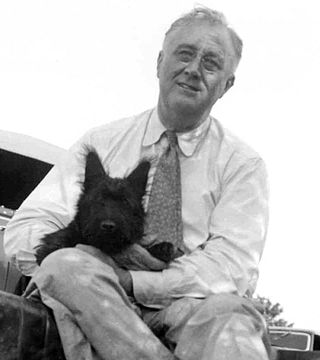
Fala, a Scottish Terrier, was the dog of United States president Franklin D. Roosevelt. One of the most famous presidential pets, Fala was taken to many places by Roosevelt. Given to the Roosevelts by a cousin, Fala knew how to perform tricks; the dog and his White House antics were mentioned frequently by the media and often referenced by Roosevelt and his wife Eleanor. Fala outlived Roosevelt by seven years and was buried near him.

Marguerite Alice "Missy" LeHand was a private secretary to U.S. President Franklin D. Roosevelt (FDR) for 21 years. According to LeHand's biographer Kathryn Smith in The Gatekeeper, she eventually functioned as White House Chief of Staff, the only woman in American history to do so.

Elizabeth Shoumatoff, née Avinoff, was a portrait painter who painted the Unfinished portrait of Franklin D. Roosevelt. Other paintings of White House residents include portraits of President Lyndon B. Johnson and Lady Bird Johnson. She painted renowned American business leaders such as Richard K. Mellon of the Mellon Bank, Thomas J. Watson, Sr. of IBM, Robert W. Woodruff of Coca-Cola, Harvey Firestone, the Hunts, the Heinzes and the Duponts. Shoumatoff painted multiple generations of prominent families such as Fricks, Whitneys, Phipps and countless others. She also painted international leaders, including William Tubman, president of Liberia, Rabindranath Tagore the Nobel Prize-winning Bengali poet, the grandchildren of Charlotte, Grand Duchess of Luxembourg and Anne Cox Chambers, U.S. Ambassador to Belgium.
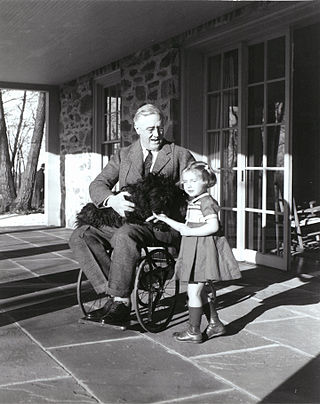
Franklin D. Roosevelt, later the 32nd president of the United States from 1933 to 1945, began experiencing symptoms of a paralytic illness in 1921 when he was 39 years old. His main symptoms were fevers; symmetric, ascending paralysis; facial paralysis; bowel and bladder dysfunction; numbness and hyperesthesia; and a descending pattern of recovery. He was diagnosed with poliomyelitis and underwent years of therapy, including hydrotherapy at Warm Springs, Georgia. Roosevelt remained paralyzed from the waist down and relied on a wheelchair and leg braces for mobility, which he took efforts to conceal in public. In 1938, he founded the National Foundation for Infantile Paralysis, leading to the development of polio vaccines. Although historical accounts continue to refer to Roosevelt's case as polio, the diagnosis has been questioned in the context of modern medical science, with a competing diagnosis of Guillain–Barré syndrome proposed by some authors.

The ghost of U.S. president Abraham Lincoln, also known as the White House Ghost, is said to have haunted the White House since Lincoln's assassination in 1865. Lincoln's ghost has also been said to haunt many of his former residences in Springfield, Illinois, including his former law office.

Eleanor and Franklin is a 1976 American television miniseries starring Edward Herrmann as Franklin D. Roosevelt (FDR) and Jane Alexander as Eleanor Roosevelt which was broadcast on ABC on January 11 and 12, 1976. It is the first part in a two-part "biopic" miniseries based on Joseph P. Lash's biography and history from 1971, Eleanor and Franklin, based on their correspondence and recently opened archives. Joseph Lash was Eleanor's personal secretary and confidant. He wrote several books on the Roosevelts including some on both Eleanor and Franklin individually and was also a controversial activist in his own right in leftist, liberalism, social and labor issues of the era.

The Roosevelt Room is a meeting room in the West Wing of the White House, the home and main workplace of the president of the United States. Located in the center of the wing, near the Oval Office, it is named after two related U.S. presidents, Theodore Roosevelt and Franklin D. Roosevelt, who contributed to the wing's design.

The Polio Hall of Fame consists of a linear grouping of sculptured busts of fifteen scientists and two laymen who made important contributions to the knowledge and treatment of poliomyelitis. It is found on the outside wall of what is called Founder's Hall of the Roosevelt Warm Springs Institute for Rehabilitation in Warm Springs, Georgia, US.

Daniel Basil O'Connor was an American lawyer and nonprofit executive. In cooperation with U.S. President Franklin D. Roosevelt he started two foundations for the rehabilitation of polio patients and the research on polio prevention and treatment. From 1944 to 1949 he was chairman and president of the American Red Cross and from 1945 to 1950 he was chairman of the League of Red Cross Societies.

Top Cottage, also known as Hill-Top Cottage, in Hyde Park, New York, was a private retreat designed by and for Franklin D. Roosevelt. Built in 1938-39, during Roosevelt's second term as President of the United States, it was designed to accommodate his need for wheelchair accessibility. It was one of the earliest such buildings in the country, and the first significant building designed by a person with a disability.

Margaret Lynch Suckley was a sixth cousin, intimate friend, and confidante of US President Franklin D. Roosevelt, as well as an archivist for the first American presidential library. She was one of four women at the Little White House with Roosevelt in Warm Springs, Georgia, when he died of a cerebral hemorrhage in 1945.

Warm Springs Historic District is a historic district in Warm Springs, Georgia, United States. It includes Franklin Delano Roosevelt's Little White House and the Roosevelt Warm Springs Institute for Rehabilitation, where Roosevelt indulged in its warm springs. Other buildings in the district tend to range from the 1920s and 1930s. Much of the district looks the same as it did when Roosevelt frequented the area.
